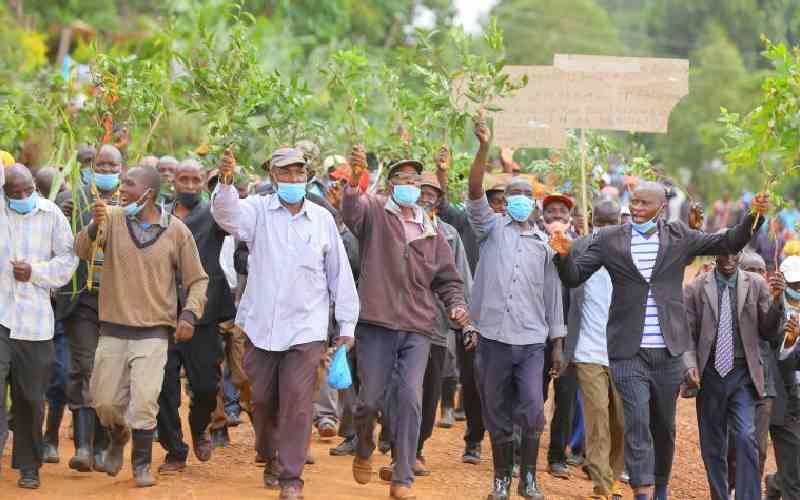By ANTONY GITONGA
Trans Nzoia, Samburu and Kitui counties
For any farmer, large tracks of green maize plantations are a joy to watch as the plants sway from side to side. The lush green vegetation, healthy livestock and children playing in the fields are a common sight in Kitale.
Considered to be the country’s food basket, this town and its environs have supplied maize to Kenyans for years during rainy and dry seasons due to the frequent showers and ‘controlled’ sun.
But hundreds of kilometres away in Samburu, swirling dusty winds, emaciated livestock and dry shrubs dot the vast, empty landscape. Dry riverbeds, rotting carcasses and weak women with babies strapped to their backs as they walk long distances in search of water is the norm in this area that has suffered for years due to harsh weather.
However, a new report warns of a geographic shift in maize production in the country as rising temperatures could make it impractical in parts of Rift Valley. The report shows that the rains could increase in arid and semi-arid regions like Samburu and Kitui, to where maize farming will shift.
The climate change report paints a grim picture for the ever green Kitale and others parts of Rift Valley. The report, Climate Change to Shift Kenya’s Breadbaskets, shows the country’s reliance on parts of the North Rift in terms of grain production shifting to Kitui and Samburu that for years have known harsh weather and lesser rainfall.
While releasing the report, experts have warned that the country’s weather patterns will adversely change between now and 2050.
The International Food Policy Research Institute and the Association for Strengthening Agricultural Research in Eastern and Central Africa (ASARECA) prepared the report released by Climate Change, Agriculture and Food Security (CCAFS). It warns that there is a “low adaptive capacity” in Kenya’s farming sector due to limited economic resources, heavy reliance on rain-fed agriculture, frequent droughts, floods and poverty.
According to one of the researchers, Michael Waithaka from ASARECA, rising temperatures could make maize production impractical in parts of the Rift Valley.
He notes that predictions in the analysis employed data from four different climate models to assess the impact on crop yields at over 6,000 locations.
Waithaka, who leads the Policy Analysis and Advocacy Programme says one research model has indicated that the high temperatures will see yields at the Coast also drop by over 25 per cent.
“The research shows rainfall levels increasing in arid and semi-arid parts of Kenya like Kitui, Samburu and Isiolo, allowing maize growing to be carried out,” he says.
According to him, another model showed growing conditions improving throughout the country thus boosting maize yields everywhere. “All models showed rainfall increasing in certain arid and semi-arid regions,” he says. Waithaka notes that if climate change stunts maize production in parts of the country, one option would be to help farmers migrate to new maize-friendly areas.
CCAFS regional programme leader for East Africa James Kinyangi notes that the change will be gradual, adding that the affected communities will have time to embrace new farming methods. “As long as we offer farmers the right services and policies, Kenya can make a major transformation in its ability to cope with the changing climate,” he says.
Stay informed. Subscribe to our newsletter
Kinyangi adds that other cereals, especially wheat, will also be affected, with production falling in parts of Mt Kenya and Elgon and increasing in parts of Central Rift Valley.
He says CCAFS is already working with the government and other partners to ensure that farmers are in a position to adapt to any changes that might occur. Kinyangi says they are working with Kenya Agricultural Research Institute and the Ministry of Agriculture to introduce sorghum, pigeon peas, cowpeas, green grams and sweet potatoes to supplement maize and other traditional staples.
“By pursuing this very inclusive adaptation planning process, Kenya is leading by example on how we can ensure African farmers are prepared for climate change,” he says.
The parliamentary departmental committee on environmental and natural resources chair, Amina Abdallah, has admitted that the effects of climate change are already being felt in the country.
 The Standard Group Plc is a
multi-media organization with investments in media platforms spanning newspaper
print operations, television, radio broadcasting, digital and online services. The
Standard Group is recognized as a leading multi-media house in Kenya with a key
influence in matters of national and international interest.
The Standard Group Plc is a
multi-media organization with investments in media platforms spanning newspaper
print operations, television, radio broadcasting, digital and online services. The
Standard Group is recognized as a leading multi-media house in Kenya with a key
influence in matters of national and international interest.
 The Standard Group Plc is a
multi-media organization with investments in media platforms spanning newspaper
print operations, television, radio broadcasting, digital and online services. The
Standard Group is recognized as a leading multi-media house in Kenya with a key
influence in matters of national and international interest.
The Standard Group Plc is a
multi-media organization with investments in media platforms spanning newspaper
print operations, television, radio broadcasting, digital and online services. The
Standard Group is recognized as a leading multi-media house in Kenya with a key
influence in matters of national and international interest.








